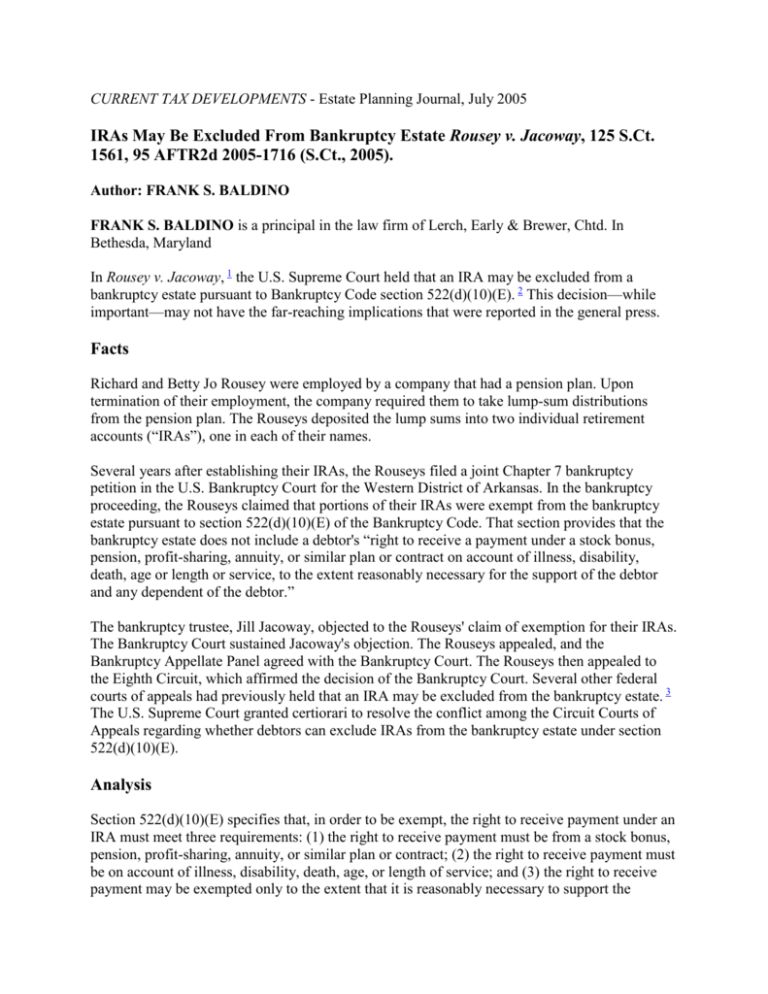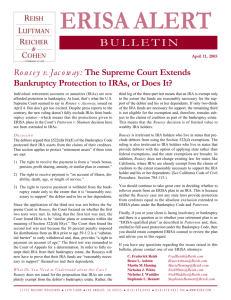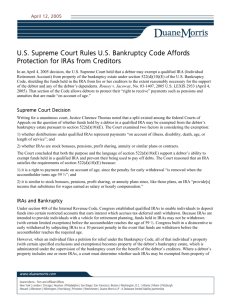
CURRENT TAX DEVELOPMENTS - Estate Planning Journal, July 2005
IRAs May Be Excluded From Bankruptcy Estate Rousey v. Jacoway, 125 S.Ct.
1561, 95 AFTR2d 2005-1716 (S.Ct., 2005).
Author: FRANK S. BALDINO
FRANK S. BALDINO is a principal in the law firm of Lerch, Early & Brewer, Chtd. In
Bethesda, Maryland
In Rousey v. Jacoway, 1 the U.S. Supreme Court held that an IRA may be excluded from a
bankruptcy estate pursuant to Bankruptcy Code section 522(d)(10)(E). 2 This decision—while
important—may not have the far-reaching implications that were reported in the general press.
Facts
Richard and Betty Jo Rousey were employed by a company that had a pension plan. Upon
termination of their employment, the company required them to take lump-sum distributions
from the pension plan. The Rouseys deposited the lump sums into two individual retirement
accounts (“IRAs”), one in each of their names.
Several years after establishing their IRAs, the Rouseys filed a joint Chapter 7 bankruptcy
petition in the U.S. Bankruptcy Court for the Western District of Arkansas. In the bankruptcy
proceeding, the Rouseys claimed that portions of their IRAs were exempt from the bankruptcy
estate pursuant to section 522(d)(10)(E) of the Bankruptcy Code. That section provides that the
bankruptcy estate does not include a debtor's “right to receive a payment under a stock bonus,
pension, profit-sharing, annuity, or similar plan or contract on account of illness, disability,
death, age or length or service, to the extent reasonably necessary for the support of the debtor
and any dependent of the debtor.”
The bankruptcy trustee, Jill Jacoway, objected to the Rouseys' claim of exemption for their IRAs.
The Bankruptcy Court sustained Jacoway's objection. The Rouseys appealed, and the
Bankruptcy Appellate Panel agreed with the Bankruptcy Court. The Rouseys then appealed to
the Eighth Circuit, which affirmed the decision of the Bankruptcy Court. Several other federal
courts of appeals had previously held that an IRA may be excluded from the bankruptcy estate. 3
The U.S. Supreme Court granted certiorari to resolve the conflict among the Circuit Courts of
Appeals regarding whether debtors can exclude IRAs from the bankruptcy estate under section
522(d)(10)(E).
Analysis
Section 522(d)(10)(E) specifies that, in order to be exempt, the right to receive payment under an
IRA must meet three requirements: (1) the right to receive payment must be from a stock bonus,
pension, profit-sharing, annuity, or similar plan or contract; (2) the right to receive payment must
be on account of illness, disability, death, age, or length of service; and (3) the right to receive
payment may be exempted only to the extent that it is reasonably necessary to support the
account holder or his or her dependents. The issue before the Supreme Court was whether the
Rouseys' IRAs satisfied the first and second requirements.
The Supreme Court began its analysis by considering whether the second requirement was met—
that is, whether the right to payments from an IRA are on account of illness, disability, death,
age, or length of service. The bankruptcy trustee contended that this requirement was not
satisfied because the Rouseys could withdraw funds from their IRAs for any reason, at any time,
as long as they were willing to pay the 10% penalty. Therefore, the bankruptcy trustee argued,
the right to payment from an IRA is not on account of age or any other factor listed in section
522(d)(10)(E).
The Court disagreed and found that the 10% penalty on withdrawals prior to age 59-1/2 is a
substantial penalty (as evidenced by the low rates of early withdrawals from IRAs), and the
Court stated that Congress imposed the penalty to preclude early access to IRAs. The Court held
that the fact that the requirement of paying the 10% penalty is removed when the account holder
turns age 59-1/2 makes the account holder's right to the balance of the IRA a right to payment on
account of age, thus satisfying the second requirement.
The Court next turned to the first requirement—that is, whether an IRA is a stock bonus,
pension, profit-sharing, annuity, or similar plan or contract. The Court agreed with the Rouseys
that an IRA is similar to the plans listed in Bankruptcy Code section 522(d)(10)(E) because both
an IRA and the listed plans are designed to provide a substitute for wages and are distinguishable
from a typical savings account.
There were several considerations that led the Court to find that payments from an IRA are a
substitute for wages. First, the minimum distribution rules require distributions from IRAs to
commence no later than the calendar year after the account owner turns age 70-1/2; the Court
found that this is the time when account holders are likely to be retired and lack wage income.
Second, account holders are encouraged to wait until retirement to withdraw payments from an
IRA because amounts in an IRA are subject to tax only upon withdrawal. Third, withdrawals
before age 59-1/2 are subject to a penalty, which restricts access to the IRA prior to retirement.
Finally, to ensure that account holders use the funds in an IRA during their retirement years, a
50% penalty applies to amounts not withdrawn in compliance with the minimum distribution
rules.
Jacoway (the bankruptcy trustee) contended that an IRA is distinguishable from the accounts
listed in the Bankruptcy Code because an IRA account holder has complete access to his or her
account. The Court rejected this argument, based on its finding that the 10% penalty erected a
substantial barrier to early withdrawals from IRAs. The Court also rejected Jacoway's contention
that the exceptions to the 10% penalty make an IRA similar to a savings account. The Court
found these exceptions to be limited in both scope and amount.
The Court therefore held that an IRA is exempt from the bankruptcy estate under Bankruptcy
Code section 522(d)(10)(E) because an IRA confers a right to receive payment on account of age
and is a plan or contract similar to a stock bonus, pension, profit-sharing, or annuity.
Comments
The Rousey decision does not fully exclude IRAs from the bankruptcy estate in all cases for
several reasons. First, an IRA is exempt under section 522(d)(10)(E) only to the extent the IRA
funds are reasonably necessary for the support of the debtor and his or her dependents. Thus, for
wealthy clients with large balances in their IRAs, Rousey may be of limited value.
Second, under current bankruptcy law, the determination of which assets are exempt is made
under the law of the state where the debtor resides. The laws of some states permit the debtor to
choose either the exemptions set out in the federal Bankruptcy Code or the exemptions set out in
the state law. Other states permit only the use of their state law exemptions, and still other states
do not provide any state exemptions, so that debtors residing in those states must rely only on the
federal exemptions. Therefore, Rousey will have no applicability to those debtors who reside in
states that prohibit the use of the federal exemptions, or to those debtors who reside in states that
provide debtors with the option of choosing either the federal or state exemptions and debtors
elect to use the state exemptions.
Third, the subject of bankruptcy protection for IRAs is also addressed in section 224(e) of the
recently enacted Bankruptcy Abuse Prevention and Consumer Protection Act of 2005, which
generally exempts from the bankruptcy estate IRAs and Roth IRAs (other than SEPs or Simple
plans) to the extent that their aggregate value, without regard to amounts attributable to rollover
contributions, and earnings thereon, does not exceed $1 million.
Finally, the decision in Rousey may not apply to Roth IRAs. Many of the reasons given by the
court for its holding that an IRA is a substitute for wages do not apply to a Roth IRA. For
example, the applicability of the 10% penalty on Roth IRAs is narrower than its applicability to
regular IRAs. Moreover, the minimum distribution rules do not apply to Roth IRAs. In addition,
there is no tax deferral with respect to a Roth IRA since withdrawals from a Roth IRA are taxfree. Consequently, it is not entirely clear whether the decision in Rousey would be extended to
Roth IRAs.
For these reasons regarding the scope of the Rousey decision, and because assets in an ERISA
plan have absolute protection from the claims of creditors in bankruptcy, 4 clients and their
advisors should continue to consider carefully whether or not to roll over assets from an ERISA
plan to an IRA.
1
95 AFTR 2d 2005-1716, 34 EBC 1929, 2005-1 USTC ¶50258 (S.Ct., 2005).
2
.
3
See In re Brucher, 243 F3d 242, 25 EBC 2103 (CA-6, 2001); In re McKown, 203 F3d 1188, 23
EBC 2895 (CA-9, 2000); In re Dubroff, 119 F3d 75, 97-2 USTC ¶50533 (CA-2, 1997); In re
Carmichael, 100 F3d 375 (CA-5, 1996).
4
Patterson v. Shumate, 504 US 753, 119 L Ed 2d 519, 15 EBC 1481 (S.Ct., 1992).
© Copyright 2005 RIA. All rights reserved.








